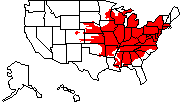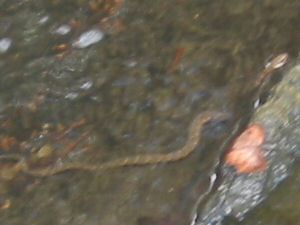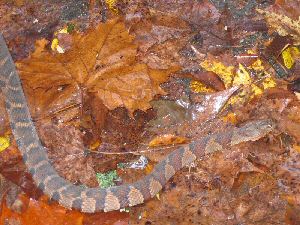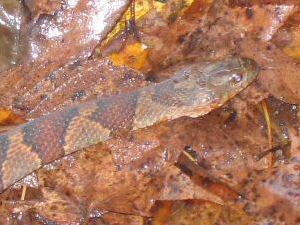|
Midland Water Snake
|
- Order: Squamata (scaled reptiles)
- Suborder: Serpentes (=Ophidia) (snakes)
- Family: Colubridae ("typical"
snakes)
- Genus: Nerodia (water snakes)
|
| Also Known As: Northern
Water Snake (all Nerodia sipedon subspecies), common water
snake |
Scientific Name: Nerodia sipedon
pleuralis (Cope, 1892) |
| Habitat: Most
aquatic environs; streams, ponds, lakes, for example. |
Nereis=the name of a Greek sea nymph; sepedon="decay,"
referring to the effects of snakebite; pleura="rib/side;"
alis="pertaining to," pertaining to the markings
on the sides of this snake
|
| Length: to about 4.5
feet. |
|
| Food: Fish, frogs,
tadpoles, other aquatic life. |
 |
| NOTE: map indicates range
of the entire Nerodia sipedon species.
I've found a few of these snakes, some in Arkansas and one in
Missouri (though I wasn't able to photograph it). This first
picture is of a young (around 2 feet long) snake in a creek in Hot
Springs, Arkansas. |
 |
| The snake pictured at right was
found by a fellow herper in our campground during a herpetological
survey of Howard County, Arkansas. It was around 3 feet long
and ill-tempered!
The water snakes in much of Arkansas are considered to be
within the intergrade zone between Nerodia sipedon sipedon
and N. s. pleuralis. The primary difference between
the two is that on sipedon, the dark bands are wider, and
on pleuralis the light bands are wider. |
 |
| This is a close-up of the above
picture. Many people mistake these and other water snakes
for the venomous cottonmouth (water moccasin), and kill
them. There is no need to do so, since these snakes are
relatively harmless (though some individuals will bite if
handled). The biggest drawback to picking these snakes up is
that they (like many other snakes) can emit "musk" from
their vent, and it STINKS! |
 |
|
|
|
|
|
|